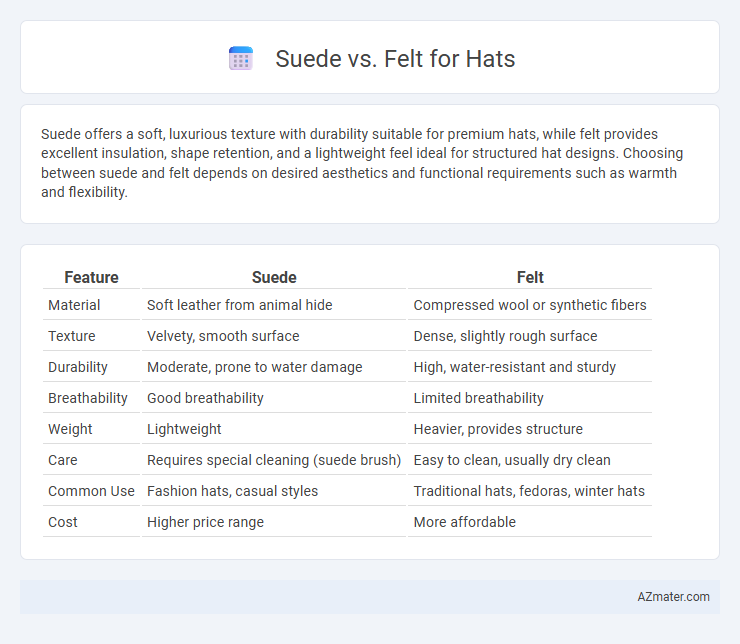Suede offers a soft, luxurious texture with durability suitable for premium hats, while felt provides excellent insulation, shape retention, and a lightweight feel ideal for structured hat designs. Choosing between suede and felt depends on desired aesthetics and functional requirements such as warmth and flexibility.
Table of Comparison
| Feature | Suede | Felt |
|---|---|---|
| Material | Soft leather from animal hide | Compressed wool or synthetic fibers |
| Texture | Velvety, smooth surface | Dense, slightly rough surface |
| Durability | Moderate, prone to water damage | High, water-resistant and sturdy |
| Breathability | Good breathability | Limited breathability |
| Weight | Lightweight | Heavier, provides structure |
| Care | Requires special cleaning (suede brush) | Easy to clean, usually dry clean |
| Common Use | Fashion hats, casual styles | Traditional hats, fedoras, winter hats |
| Cost | Higher price range | More affordable |
Introduction to Suede and Felt Hats
Suede hats, made from the underside of animal hides, are prized for their soft texture and luxurious appearance, offering both durability and breathability ideal for stylish headwear. Felt hats, crafted from compressed wool or fur fibers, provide excellent insulation and a smooth, versatile finish that suits various climates and fashion styles. Choosing between suede and felt depends on the desired balance of texture, warmth, and water resistance in hat construction.
Material Origins: What is Suede? What is Felt?
Suede is a type of leather made from the underside of animal hides, primarily lamb, goat, or calf, known for its soft, napped finish and supple texture, making it a luxurious choice for hat materials. Felt is a non-woven fabric produced by matting and compressing fibers such as wool, fur, or synthetic materials, resulting in a dense, durable, and moldable textile commonly used in traditional hat making. The key difference lies in suede being a natural leather derivative with a smooth, velvety surface, while felt is a compressed fiber fabric valued for its structure and insulating properties.
Texture and Appearance Comparison
Suede offers a soft, velvety texture with a natural nap that gives hats a luxurious, matte finish, enhancing their tactile appeal. Felt, made from compressed wool or synthetic fibers, has a smooth, dense surface that provides a more uniform look with slight fuzziness, lending hats a classic and structured appearance. The contrast in textures makes suede ideal for casual, stylish hats while felt suits traditional, formal styles with its crisp and refined aesthetic.
Comfort and Wearability
Suede offers a soft, supple texture that molds comfortably to the head, providing a luxurious feel ideal for extended wear. Felt, typically made from wool or synthetic fibers, delivers excellent breathability and durability, ensuring comfort across various climates. Both materials provide distinct wearability advantages, with suede excelling in softness and felt in moisture-wicking and temperature regulation.
Durability and Longevity
Suede offers moderate durability with a soft texture that can wear down faster when exposed to moisture and abrasion, making it less suitable for harsh environments. Felt, typically made from compressed wool or synthetic fibers, exhibits higher resistance to wear, water, and deformation, ensuring longer lifespan and maintaining shape over extended use. For hats, felt is generally favored for durability and longevity, especially in outdoor or everyday wear conditions.
Weather Resistance and Seasonal Suitability
Suede offers moderate weather resistance, performing well in dry and cool conditions but requires careful maintenance to avoid water damage, making it ideal for fall and mild winter use. Felt provides superior weather resistance, especially wool felt, which repels moisture and retains warmth, making it suitable for colder, wetter climates and winter seasons. Choosing between suede and felt depends on the regional weather patterns and the desired balance between style and functional protection.
Style Versatility and Fashion Appeal
Suede hats offer a luxurious texture with a smooth, velvety finish that elevates casual and semi-formal looks, making them ideal for stylish, versatile wardrobe staples. Felt hats provide a classic, structured silhouette favored in both traditional and contemporary fashion, excelling in cold-weather wear with their durability and refined aesthetic. Both materials enhance hat style versatility, but suede emphasizes a softer, trendier appeal while felt prioritizes timeless sophistication and robustness.
Maintenance and Cleaning Requirements
Suede hats require gentle cleaning with a suede brush to remove dirt and restore the nap, while felt hats benefit from a soft-bristle brush or lint roller to maintain fiber integrity and remove debris. Both materials should be kept dry, but felt is generally more resistant to water stains compared to suede, which can easily be damaged by moisture and needs specialized suede cleaner for tough stains. Proper storage in a cool, dry place preserves the shape and texture of suede and felt hats, preventing mildew and deformation.
Price Considerations and Value
Suede hats typically cost more due to the premium quality and durability of the natural leather material compared to felt, which is often made from wool or synthetic fibers. Felt hats offer a more affordable option while still providing reasonable warmth and style, especially in mass-produced varieties. When considering value, suede provides long-term durability and a luxurious feel, justifying its higher price for those seeking longevity and premium aesthetics.
Choosing the Best Material for Your Hat
Suede offers a soft, luxurious texture ideal for stylish, high-end hats, while felt provides superior durability and water resistance, making it practical for everyday wear. Felt hats maintain their shape well under various weather conditions and are often preferred in colder climates, whereas suede hats require more careful maintenance to avoid damage from moisture. When choosing the best material for your hat, consider the climate, intended use, and the balance between elegance and functionality.

Infographic: Suede vs Felt for Hat
 azmater.com
azmater.com